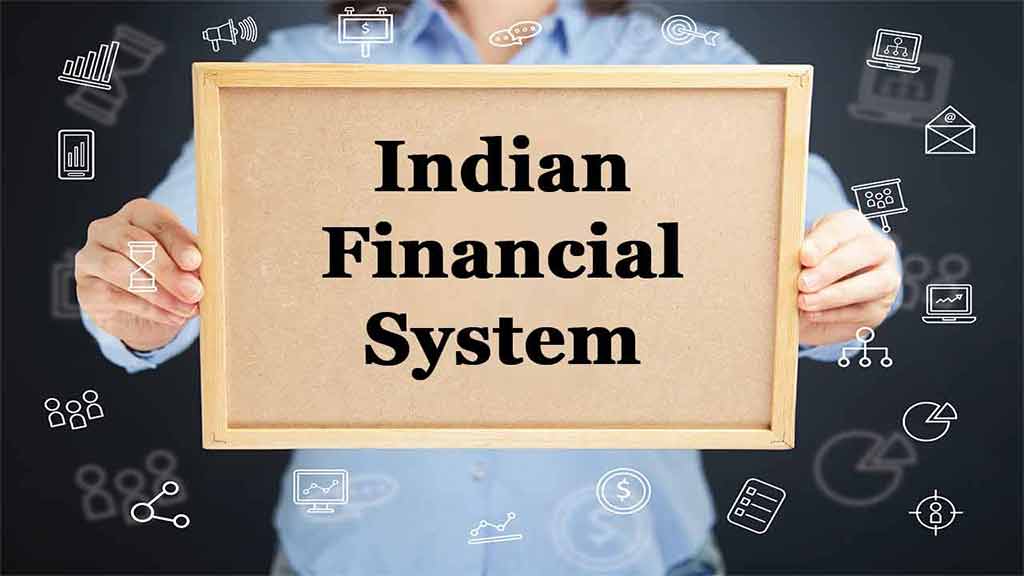Components and Functions of Indian Financial System: For every country, financial system is the backbone of development. This system takes care of or controls transactions of funds and fulfills the recruitment where necessary.
If you are an aspirant of government examination, then you must have clear understanding about the Financial System in India.
The following article will help you to know about the Indian Financial System, their components, and also their role in the economic development of India.
About Indian Financial System

Also Read: What is GDP?
The financial system has essential role for the economic growth of a country. It facilitates a channel between households (savers) to business firms (investors) to flow funds.
The flow of funds of this kind helps to create assets and improvement of both. That means financial system investors can utilize the money of a saver for development purpose and get a good return as a result.
The services provided to the people through Financial Institutions such as banks, insurance companies, pensions, funds, etc. that forms a complete Financial System.
Features:
- For the development of a country, it has major contribution.
- It helps to indirectly connect investors with the people (savers).
- It controls the flow of funds.
- It helps the financial institutions and market to expand.
- It facilitates capital formation.
Components of Financial System
Financial Institutions
The financial institutions are essential to finance different projects time to time. They collect funds from savers and facilitates this funds to the investors in the form of stocks, bonds, bank deposits, loans etc. There are some functions of this kind of Financial Institutions are:
- Liabilities can be converted from short term to long term investment.
- It makes risky investment to risk free investment for customer’s ease.
You can better understand by one of the Financial Institutions that is bank. We can divide financial institutions into two types:
- Banking Institutions/Depository Institutions: A financial institution accepts deposits from people providing some interest in return and lend it to the prospective person or organizations and person withdraw their funds from their accounts through cheque.
- Non-Banking Institutions/Non-Depository Institutions: For the non-banking institutions, all the functions are same as banking but depositor are not allowed to issue cheque and also cannot withdraw money from their deposits such as Insurance, mutual funds etc.
It can also further divide into three categories as below:
- Regulatory: Financial Markets are regulated by RBI, IRDA, SEBI etc. and also encourage the investors.
- Intermediates: In this category, commercial banks are mainly included such as SBI, BOB, PNB, etc. which facilitates loans for and other financial facilities to the corporate customers as well as individuals.
- Non-Intermediates: The main purpose for this institutions are to lend funds for a long term to the corporate customers. NABARD, SIBDI, IDBI are included in it.
Financial Assets/Instruments
Financial assets are those through which transactions are conducted with customers such as cash deposits, checks, loans, letter of credit, bank notes etc. We will briefly discuss about some important financial assets below:
- Call Money: When an amount of loan is granted on overnight basis and paid back on the next day is known as Call Money. Uncollateralized funding is taken place in this case. Scheduled Commercial Banks (SCBs) are the participants in the call money market.
- Notice Money: When fund is provided for less than 14 days but more than one day is known as Notice Money. Uncollateralized borrowing as well as lending is taken place here.
- Term Money: When the deposit’s maturity period is more than 14 days, known as Term Money.
- Treasury Bills: Popularly known as TBs or T-Bills. This kind of instruments are in existence since 1986. Period of this type of borrowing is up to 365 days to fulfill short term requirements.
- Certificate of Deposits (CD): Come into existence in 1989 and used by banks to fulfill demands of liquid for less than one year which is negotiable and tradable. In 1993, RBI allowed some financial institutions such as IFCI, IDBI, IRBI etc. to operate in it.
- Commercial Paper (CP): Set up in 1990 which is applied by corporate houses to a listed company having working capital greater than 5 crores.
Also Read: Types of Banks in India
Financial Services
Financial services are the services which are concerned with Asset Management and Liability Management of companies. The services provided by the financial institutions are:
- Banking Services: All the services given by banks such as issuing debit/credit cards, opening accounts, etc.
- Insurance Services: Selling and issuing of insurance policies, undertaking and brokerages of insurance are included in Insurance Services.
- Investment Services: Mainly, asset management, hedge fund management and the custody services are the part of this services.
- Foreign Exchange services: Services like Exchange of currency, foreign exchange, the wire transfer etc. are falls in this services.
Through this services financial institutions helps to deal with selling, borrowing or purchasing securities, allowing payments etc.
Financial Markets
It is defined as a marketplace where interaction of buyers and sellers is taken place through trading of money such as bond, shares, currencies are known as Financial Markets.
This can further be divided into four different categories as:
Capital Market: Provide long-term investment and minimum period is of 365 days or above. It can be classified into three categories:
- Corporate Securities Market
- Government Securities Market
- Long Term Loan Market
Money Market: Money Market is the low-risk, highly-liquid, short-term financial market for a day up to 365 days. Dominated mainly by government, banks and financial institutions. It can be classified into two categories as –
- Organized Money Market: Come into existence since mid-1980s and started by government.
- Unorganized Money Market: Activities recognized by government and are not like organized money market. It was present before organized money market.
Foreign Exchange Market: For exchange of currencies across the world required multicurrency and this is managed by Foreign Exchange Market. Funds are transferred on the basis of current foreign currency rate.
Credit Market: A market where corporate and individuals allowed to advantage of short, medium and long-term loans from banks, Financial Institutions (FIs) and Non-Bank Financial Institutions (NBFCs) are known as Credit Market.
Financial System creates a common platform where lender and borrower come in contact with each other indirectly for their own benefits. The ultimate outcome of this is the growth and development of the country as well as individuals living of standard.
Read More: Government Jobs After MBA Finance in India
Sample Multiple Choice Questions (MCQs)
Q1. Which of the following is a type of Capital Market?
- Corporate Securities Market
- Government Securities Market
- Long Term Loan Market
- All of the Above
- None of the Above
Answer: (4) All of the Above.
Q2. Which of the following is financial asset?
- Call Money
- Treasury Bill
- Cheque
- (i) & (ii)
- (i), (ii) & (iii)
Answer: Option (4).
Q3. Which of the following is the type of financial institutions?
- Capital Market
- Call Money
- Banking Institutions
- Banking Services
Answer: (3) Banking Institutions.
Q4. In which year Certificate of Deposits (CD) came into existence?
- 1975
- 1970
- 1989
- 1991
Answer: Option (3) 1989.
Q5. Which of the following loan is lend on overnight basis?
- Term Money
- Certificate of Deposits
- Call Money
- Immediate Bill
- Notice Money
Answer: Option (3) Call Money.
Q6. Minimum capital required to borrow Commercial Paper (CP)
- 2 Crore
- 5 Crore
- 25 Crore
- 15 Crore
- 10 Crore
Answer: option (2) 5 Crore.
Descriptive questions are also asked from Indian Financial Institutions.
We hope this post will help you to know the Indian Financial System which is important for competitive exams. You can follow us on Facebook and Twitter for the latest post notifications.
Frequently Asked Questions
Q1. What do you mean by Financial System?
Ans: Institutions, markets, instruments, and services are together forms Financial Institutions.
Q2. What is the purpose of Financial System?
Ans: The Financial System allows funds to flow between the borrower and lender. Proper use of funds results development of the country.
Q3. What are the categories of Indian Financial System?
Ans: Indian Financial System is classified into two categories:
1. Indian Money Market: Short-term financial market i.e. funds are lent and borrowed for up to 365 days.
2. Indian Capital Market: Long-term financial market i.e. funds are lent and borrowed for more than 365 days.





